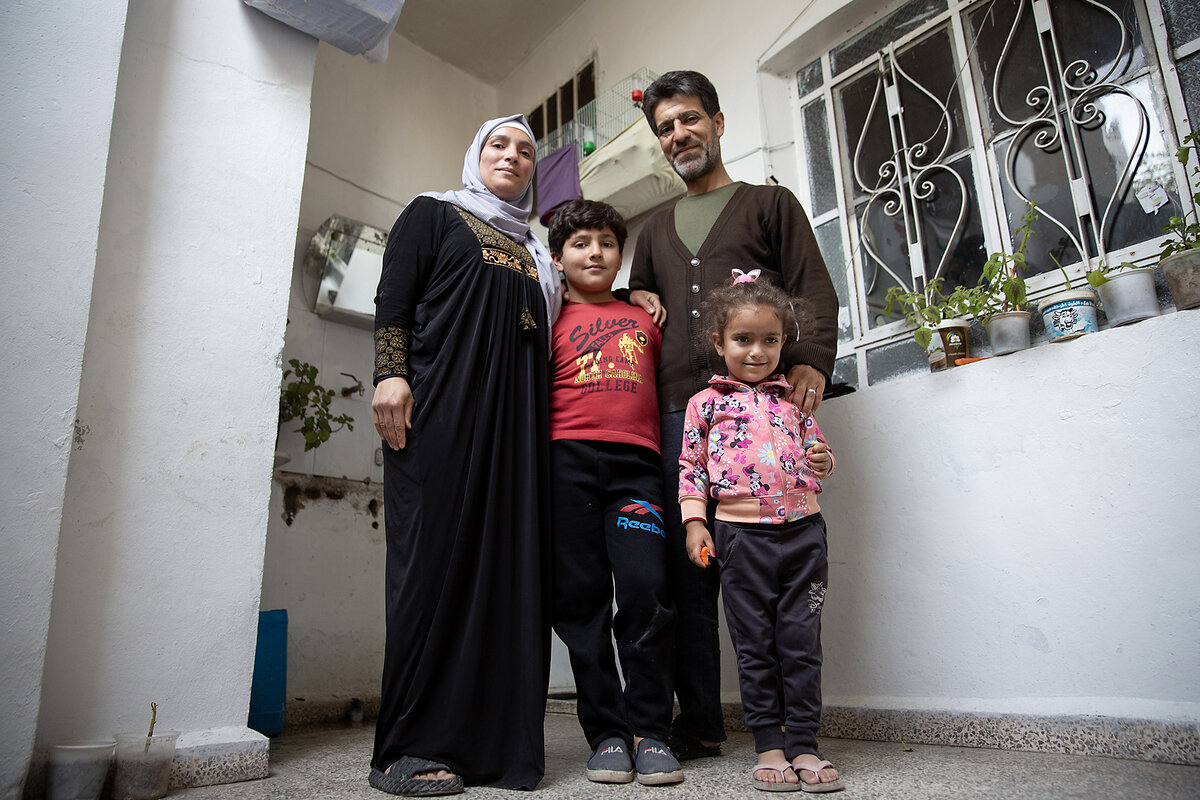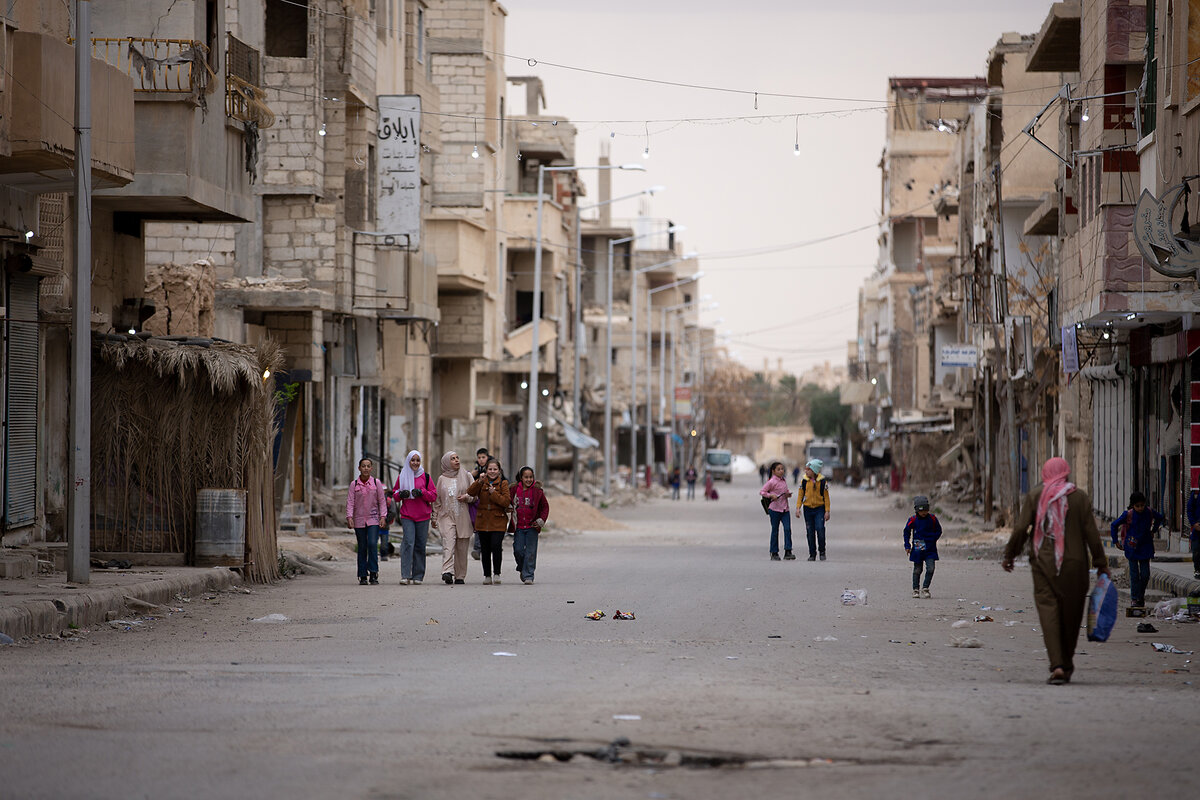Why a $4 bicycle repair signals hope for Syria’s postwar economy
Loading...
| Qaboun and Palmyra, Syria
Fawziya Saad and her 9-year-old son, Ibrahim, push a rickety bike along a road flanked by debris on the outskirts of Damascus.
Some breeze-block homes – like theirs – are in poor shape but habitable, their rusty satellite dishes gazing at hazy blue skies. Others in this Damascus suburb, Qaboun, are flattened reminders of Syria’s 14-year war, which has yet to give way to true peace or prosperity.
It’s a long walk to the repair shop, but Ibrahim doesn’t mind. He keeps up with his fast-paced mother with visible delight and determination. Finally, on this end-of-winter March afternoon, the family has gathered enough money and optimism to push his bike up their list of financial priorities.
Why We Wrote This
A story focused onAfter more than a decade of civil war, and despite substantial economic hurdles, small investments by struggling Syrian families signal faith in a life beyond conflict, and hope for the country’s future.
“We received a bonus this month,” explains Ms. Saad with a gentle smile. “So I decided to fix Ibrahim’s bicycle because he wants to play with his bike, just like his friends.”
The repair will cost about 50,000 Syrian pounds (almost $4) – or 15% of her monthly salary at a state-owned electricity company.
The choice to repair a broken bicycle may seem small, but for families like the Saads, such decisions reflect a fragile but growing faith in a life beyond conflict.
More than a decade after Syria’s war began, and months after the fall of President Bashar al-Assad, small investments – whether in homes, businesses, or children’s joy – signal hope.
Immense challenges
The obstacles to rebuilding are immense. Economic collapse, international sanctions, infrastructural devastation, and political uncertainty still cast a shadow over daily life.
The new government has promised economic liberalization and wage increases, but in real life that mostly means symbolic gestures, such as the Ramadan bonus that allowed the Saads’ bike repair.
Inflation is a major challenge. Cumulative price increases exceed 30,000% since 2011, when Syrians first revolted against Mr. Assad’s rule, according to Professor Ali Kanaan, dean of the faculty of economics at the University of Damascus. “The price of a bag of bread was 15 Syrian pounds in 2011; today, it’s 4,000 [31 cents] – and that’s the subsidized price,” he explains. “The real cost is double.”
About 80% of Syrians live below the poverty line, and the average worker earns no more than $35 a month.
Energy shortages, Professor Kanaan explains, have immobilized industries and raised transport costs. Erratic exchange rates, years of institutionalized corruption under the Assad regime, and war led to the destruction or closure of thousands of businesses.
Warlords cornered import markets. International sanctions left Syria isolated. Hundreds of thousands of people had to flee their homes.
A key issue facing the government is the shortage of oil derivatives and electricity, stresses Professor Kanaan. Solving that problem would enable small factories and workshops to resume operations.
There is hope that a recent agreement with the Kurdish-led Syrian Democratic Forces, whose area of control extends to the oil fields in the country’s northeast, could pave the way to securing energy resources and even enable exports.
The second challenge is the urgent need to raise salaries and wages. The transitional “rescue government” pledged a 400% salary increase, potentially bringing monthly income to around $120. This goal could be reached through deficit financing or by securing external aid, Professor Kanaan says.
“One of the main economic problems in Damascus is the rise in prices,” he says, blaming traders who pursue exaggerated profits.
Slowly climbing out of debt
To feed four people and a pair of lovebirds, the Saad household counts on two salaries. They add up to about 700,000 Syrian pounds a month. It’s better than many but still not enough to make ends meet. Husband and wife struggle to pay off debts large and small, month by month.
“Our economic situation is just below average,” Ms. Saad says. “We will only be able to say it is good when we pay off all our debts.”
She pays off supermarket and grocery store debts at the start of each month, then falls back into debt by the end of it. Her husband, Basem, is even deeper in debt, despite supplementing his public sector messenger salary with a side gig as a car washer. His debts add up to five months’ pay.
“I borrow money from my workmates, the grocery store, my relatives, and people who know me, and I gradually pay off my debts,” Mr. Saad says. “Every month, I give each one of them a portion of what I owe. Currently, I’m looking for another job.”
He needs a better salary to repair the family home’s shattered walls and a hole in the roof, he says. As he talks, the Saads’ 4-year-old daughter, Nour, expertly scrambles up a dangerously uneven, open staircase.
The challenges are even more acute for families that do not have access to a regular salary.
In the ancient Roman city of Palmyra, which once lived from its olive and date groves as much as from international tourists drawn by its majestic ruins, displaced families are returning to broken homes. They are eager to rebuild their lives, but lack the income and tools they need to do so.
“Just because we asked for freedom – all the [historic] ruins and the city are destroyed,” laments Mohammed Mashaal, who returned to Palmyra from the destitute Rukban camp near Jordan. He now dreams of turning his shattered sandwich shop into a library for children – the main source of energy and hope in the community.
The city, which now lies in ruins, experienced pro-Assad and Islamic State rule twice during the civil war.
Construction worker Mohamed had temporarily switched to eking out a living from nearby salt flats, because no building projects were launched with warplanes in the sky. Now he is finally back and keen to rebuild. Yet two weeks’ construction work for neighbors has earned him only $8.
“People want to be on their land, no matter what the work situation is,” he says.
Walaa Buaidani and Salman Daas supported reporting for this story.








